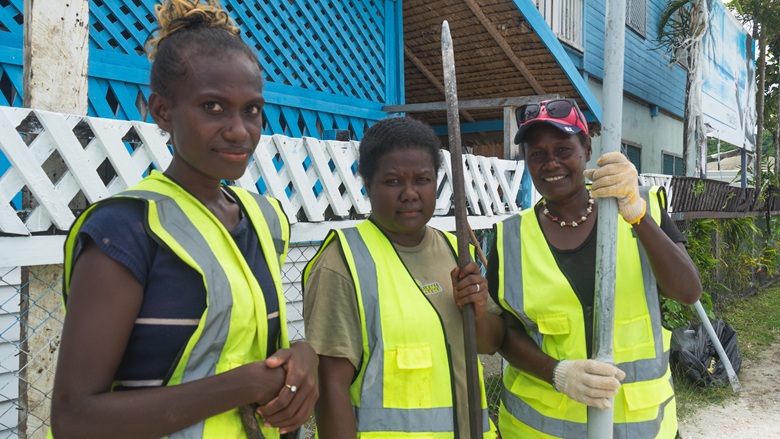Few regions have matched East Asia and Pacific’s (EAP) economic dynamism—or its success in creating more and better jobs. Over the past twenty years, the region created a net total of 131 million new jobs, underpinned by a dramatic shift of employment from traditional farming towards jobs in services and manufacturing. Most of these jobs have come from the private sector—spanning large, export-oriented firms and formal enterprises to a wide array of entrepreneurs, small businesses, and self-employed workers.
Jobs have been the most effective path out of poverty. The shift of poorer households from agriculture to relatively higher productivity manufacturing and services has been the key driver of poverty reduction in most countries in the region since 2010. For example, growth in labor income from manufacturing and services accounted for nearly all of Vietnam’s poverty reduction between 2010 and 2020, with similar patterns observed in Cambodia, the Philippines, and Thailand.
However past achievements are no guarantee for future success. Looking ahead the region’s labor markets confront new challenges. Export- and manufacturing-led growth—once a key driver of job creation in the region—is facing headwinds from automation and evolving global trade patterns. At the same time, technology is also transforming the service sector with digitization and AI driving productivity across industries such as finance, retail, and healthcare while opening up new opportunities for higher-value services and skill-intensive jobs. Meanwhile, aging populations in some countries, and large youth cohorts in others, are reshaping labor supply dynamics.
Over the next decade, about 320 million people are expected to reach working age across the region, placing significant pressure on labor markets to generate jobs at scale. Yet, with economic growth slowing in many middle-income countries, job creation is projected to lag: at current trends, only about 110 million new jobs may be added.
Young people will likely be hardest hit. Despite generally low overall unemployment, job prospects for youth have dimmed, especially compared to pre-pandemic trends. Youth unemployment remains persistently high across countries like China, Indonesia, Malaysia, and Mongolia. In Malaysia, for example, the 2024 unemployment rate averaged 3.3%, but 13.4% of 16–24-year-olds were not in employment, education, or training (NEET). In Mongolia, youth unemployment stands at roughly 11%—more than twice the overall rate—highlighting the specific hurdles young people face entering the workforce.
But the challenge is not just about the number of jobs—it’s also about their quality. Despite steady declines, the International Labor Organization estimates that about half of all jobs remain informal, concentrated largely in low-productivity sectors like informal retail, subsistence agriculture, and low-skill services. After rapid industrialization, employment in recent years has shifted mainly from low-productivity agriculture to similarly low-productivity services, with fewer jobs moving into higher-productivity manufacturing and services. To help more people—especially the region’s growing urban youth—transition into formal, productive, and better-paying jobs, millions of such opportunities must be created across countries in the region.
Countries with aging populations—such as China, Thailand, Viet Nam, and Mongolia—must simultaneously adapt their labor markets and social protection systems to a rapidly shrinking working-age population. In the next decade, every year 34 million people will turn 65 across the region. And while older workers are less likely to be unemployed, many exit the labor force early. A declining workforce can slow economic growth, increase dependency ratios, and place additional burdens on public finances as fewer workers support a growing number of retirees. These demographic shifts call for measures to extend working lives, boost female labor force participation, and make jobs more accessible and inclusive for older workers.

World Bank Support: Better Policies for Better Jobs
In this context, the World Bank Group works with governments, the private sector, and other stakeholders, helping to shape policies, finance investments in human capital and infrastructure, and catalyze private capital to create opportunities and drive job creation across the region.
The right policy and institutional environment is crucial to drive job creation at scale. Macroeconomic instability, inefficient financial and labor markets, cumbersome regulations and policy uncertainty can pose major obstacles to a private sector dynamism, investment and job creation.
Working closely with governments, the World Bank is supporting critical structural reforms to address these challenges and foster a more favorable environment in which the private sector can operate and grow. Through our analytical work, we identify key constraints that hinder job creation and provide actionable reform recommendations. To reinforce implementation, we provide development policy financing, helping to drive progress, accountability, and tangible impact.
Core analytical work includes the recently launched Country Growth and Jobs Reports which are being prepared in the Philippines and Indonesia. These reports analyze the binding constraints to growth and job creation in the country and provide practical policy recommendations to address them.
In Indonesia the forthcoming Country Growth and Jobs Reports finds that despite strong progress in reducing unemployment and poverty, there is now a growing concern: not the number of jobs, but their quality. In 2023, only 8.4% of income earners had jobs that supported a middle-class lifestyle, down from 14% in 2019. Most new employment is in low-skilled, low-productivity roles, particularly in services and lower-value manufacturing. This challenge is driven by inefficient markets that misallocate labor and capital. The dominance of large incumbent firms and state-owned enterprises reduces competitive pressure and slows job creation in dynamic, high-skilled sectors. Additionally, services—critical to creating better-paying jobs—remain highly restricted, limiting their contribution to productivity and broader employment gains. The report recommends efficiency-enhancing reforms—such as opening markets to competition, easing restrictions in services, and expanding access to finance. These reforms would not only boost investment but also improve job quality and enable more Indonesians to transition into middle-class work.
In the Philippines, the forthcoming Country Growth and Jobs Report (CGJR) analyzes the binding constraints to faster growth and better job creation, and finds that while the Philippines has made notable progress—doubling its GDP and creating 11.7 million jobs since 2010—further gains hinge on achieving four key outcomes: sustaining spatial convergence, unlocking productivity and innovation, improving resource allocation, and reversing the inward shift of the economy. To achieve these outcomes, the report proposes a set of priority reforms. For spatial convergence, the focus is on doubling down on inter- and intra-island connectivity infrastructure. For productivity and innovation, the report calls for partnering with the private sector to upskill and reskill the labor force, enabling wider technology adoption. For improved resource allocation, it emphasizes the streamlining of regulations and the full implementation of competition reforms. And to reverse the inward shift, it highlights the importance of deeper regional integration and increased competition to reduce logistics costs. The report estimates that full implementation of these reforms could generate 5.1 million additional jobs by 2040, mostly from productivity-driven increases in labor demand and from greater labor force participation—especially among women. Real wages would also rise by an estimated 12.9 percent by 2040.

Recent Development Policy Operations (DPO) across the region have supported the implementation of critical structural reforms to enable private sector investment and job creation.
For example, the Philippines Sustainable Recovery Development Policy Loan (DPL) supported reforms to open up public infrastructure services, such as domestic shipping, aviation, and telecoms to foreign investment. By mobilizing capital and spurring competition this will lower the cost and improve the quality of critical backbone infrastructure services, such as communications, transport and logistics. This is expected to increase productivity in downstream sectors, such as manufacturing, by as much as 3.2 percent on average, in turn boosting competitiveness and job creation across the economy.
In Fiji, an ongoing Fiji Growth and Resilience DPO with Cat-DDO series supports reforms to support MSMEs access to finance, which will support both business entry and growth, and cutting red tape and improving the business environment for MSMEs and in the important tourism sector.
In the Solomon Islands, an ongoing Solomon Islands Resilience DPO with Cat-DDO series supports private sector development. This includes reforms to the investment policy and Foreign Investment Act to attract more private investment as well as reforms to diversify the energy mix and reduce electricity tariffs, which are among the highest in the world, affecting competitiveness.
In Indonesia, the Indonesia Investment and Trade Reforms DPL supported reforms aimed at attracting private investment, particularly foreign direct investment (FDI) and reforming trade policy to support competitiveness and economic recovery. Key reforms included rationalization of FDI restrictions from 813 to 260, reforms to encourage private investment in the energy sector, and measures to reduce cost of compliance with national product standards. The operation, which was approved by the WB Board in June 2021, estimates that the above reforms could generate around 3.2 million new and better jobs by 2026. Moreover, realized FDI increased by 23 percent in the fully liberalized non-commodity sectors relative to the growth of the pre-policy period. Meanwhile, planned FDI grew by an average of 30.3 percent post-policy, compared to 6.2 percent pre-policy.
In Cambodia, the Cambodia Growth and Resilience DPO supported reforms to boost growth through a more competitive environment for the private sector. Key reforms included digitization and streamlining of business registration procedures to ease firm entry and formalization, measures to improve access to credit for SMEs, the adoption of the first competition law and steps to improve the insolvency framework to enable efficient exit. For instance, a key reform cut processing times for new business licenses and registrations by 30 percent, making it easier for firms to transition into the formal sector.
Building on these successes, a series of new job-oriented development policy operations are under preparation in the Philippines and Indonesia.
In the Philippines, a new Inclusive Growth and Jobs DPL will support the creation of more and better jobs by tackling key constraints to private sector investment, skills development, and labor market participation. Through reforms that improve access to finance, reduce regulatory burdens, enhance logistics and transport efficiency, and modernize training systems, the DPL fosters a more competitive and inclusive business environment. It incentivizes firm-level innovation and SME growth while formalizing and upskilling key segments of the workforce, including women and youth. These efforts are complemented by measures to improve early childhood development and align fiscal policies to support sustainable economic expansion—laying a foundation for the acceleration of job-rich, inclusive growth.
In Indonesia, a new Jobs and Growth DPL will support crucial reforms to mobilize finance and enable markets for productive, sustainable and resilient investment. Key actions aim to expand the volume and lower the cost of financing for businesses whiles easing constraints to unlock new investment opportunities. It is estimated that, if implemented, the key reforms supported by the operation could create about 700 thousand additional jobs by 2026.
